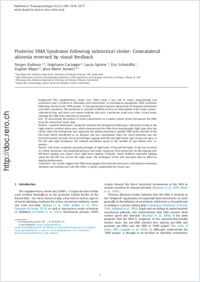Posterior SMA Syndrome following subcortical stroke: Contralateral akinesia reversed by visual feedback
- Radman, Narges Neurology Unit, Medicine Department, University of Fribourg, Switzerland
- Cacioppo, Stephanie High Performance Electrical Neuroimaging Laboratory, CCSN, Department of Psychology, University of Chicago, Chicago, IL, USA
- Spierer, Lucas Neurology Unit, Medicine Department, University of Fribourg, Switzerland
- Schmidlin, Eric Physiology Unit, Medicine Department, University of Fribourg, Switzerland
- Mayer, Eugène Department of Neurology, Geneva University Hospital, Geneva, Switzerland
- Annoni, Jean-Marie Neurology Unit, Medicine Department, University of Fribourg, Switzerland - Department of Neurology, Geneva University Hospital, Geneva, Switzerland
-
27.08.2013
Published in:
- Neuropsychologia. - 2013, vol. 51, no. 13, p. 2605–2610
English
Background: The supplementary motor area (SMA) plays a key role in motor programming and production and is involved in internally-cued movements. In neurological populations, SMA syndrome following a lesion to the “SMA proper” is characterized by transient impairment of voluntary movements and motor sequences. This syndrome is assumed to follow on from an interruption of the motor cortico-subcortical loop, and some case reports indicate that such a syndrome could occur after a brain lesion isolating the SMA from subcortical structures.Aim: To characterize the pattern of motor impairments in a patient whose stroke disconnects the SMA from the subcortical motor loop.Method: A patient developed a moderate transient left hemiparesis following a subcortical stroke in the right anterior cerebral artery area, which disconnected the SMA from basal ganglia. Eight days after the stroke, when the hemiparesis had regressed, the patient presented a specific SMA motor disorder of the left hand which manifested as an akinesia and was exacerbated when his visual attention was not directed towards his hand. We assessed finger tapping with left and right hands, eyes closed and open, in the left and right hemispace. We indexed movement speed as the number of taps filmed over 5-s periods.Results: Left motor weakness (grasping strength of right hand: 49 kg and left hand: 41 kg) was resolved in a week. Ideomotor and ideational gestures and motor sequences were preserved. On the tapping task, left-hand tapping was slower than right-hand tapping. Critically, visual feedback improved tapping speed for the left, but not for the right, hand. The hemispace of the task execution had no effect on tapping performance.Conclusion: Our results suggest that SMA-basal ganglia disconnection decreases contralateral movement initiation and maintenance and this effect is partly compensated by visual cues.
- Faculty
- Faculté des sciences et de médecine
- Department
- Médecine 3ème année
- Language
-
- English
- Classification
- Biological sciences
- License
-
License undefined
- Identifiers
-
- RERO DOC 209416
- DOI 10.1016/j.neuropsychologia.2013.08.004
- Persistent URL
- https://folia.unifr.ch/unifr/documents/303592
Statistics
Document views: 115
File downloads:
- pdf: 233
